The Boeing B-29 Superfortress is best known as the aircraft that dropped the Atomic Bomb on Hiroshima and Nagasaki. But, the B-29 was also a truly revolutionary aircraft. In fact, it was the most technologically advanced bomber of World War II.
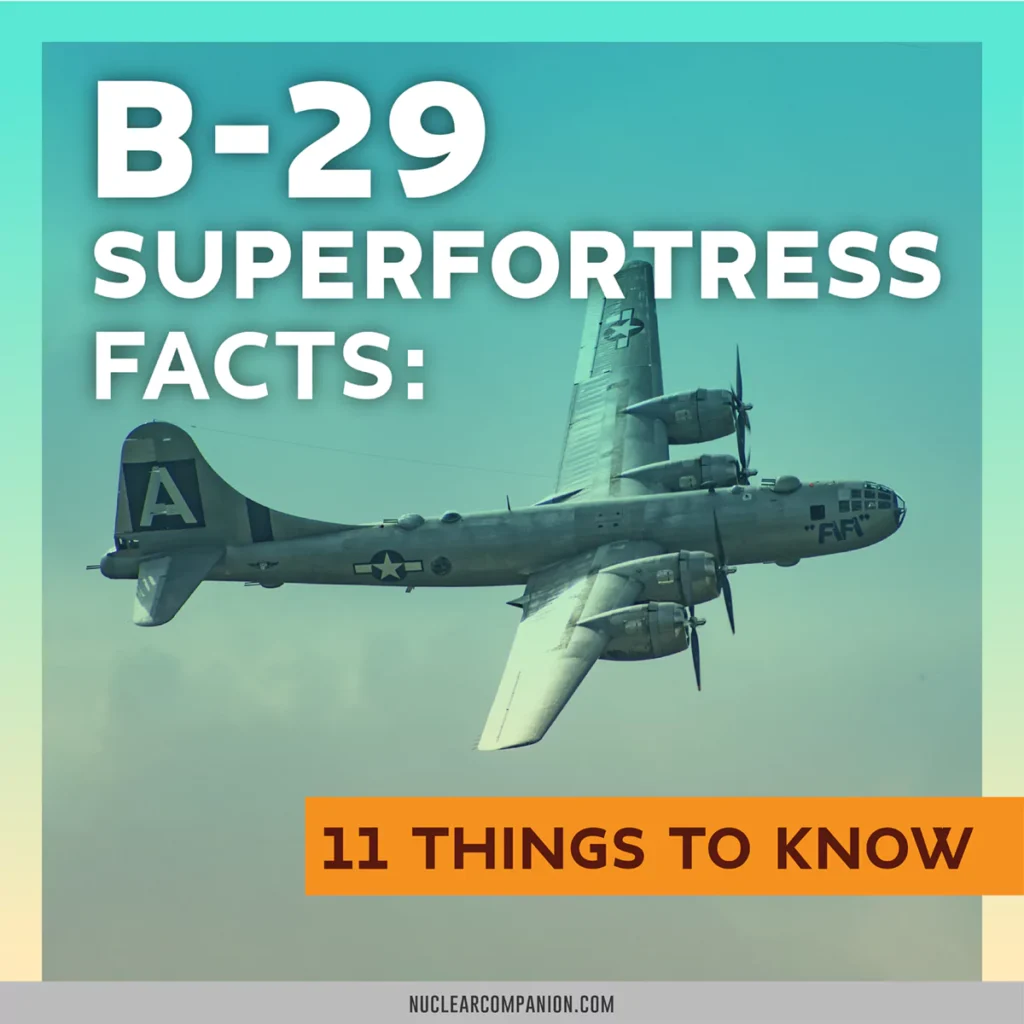
Let’s get right into it.
1) The B-29 was the most advanced and capable bomber of World War II
The B-29 was the “SuperBomber” of WWII. In fact, it was a technical marvel that made obsolete previous bombers.
By today’s standards, it should be considered obsolete but at the time it represented a tremendous leap forward in technology. In fact, B-29 engines and avionics were at the leading edge of aviation technology. Also, it made it the world’s most complex aircraft when first designed.

It introduced features that had never been seen or tried before
First, It introduced features that had never been seen or tried before. These included:
- Two computerized precision radar bombing systems (the AN/APQ‑13 and AN/APQ‑7 Eagle),
- The most advanced computer-aided remote-controlled turret fire control system in existence (CFC system)
- The largest piston turbocharged engines built during the war
- Added a new member to the crew: a flight engineer. This new role would greatly aid in flying this complex aircraft.
- Electrically-retractable tricycle undercarriage
- Dual tandem bomb-bays
- Cabin pressurization and heating for crew comfort
It was an “all-electric” aircraft
That is, the only moving part not connected to a cable or an electric motor was the hydraulic braking system. For that purpose, the B-29 had 150 electric motors powered by six engine-driven generators per engine and connected by eleven miles of wiring. These were the largest generators then installed on an aircraft.
Its avionics were at the leading edge of aviation technology
Boeing designed the B-29 to be the first bomber to carry a ground-mapping radar from the start. A ground mapping radar is capable of contrasting land and water allowing navigators to find the target area in coastal cities.

One B-29 in four carried an APR-4 radar intercept receiver and an additional crewman to operate it. This radar let the B-29 collect the radiation from the enemy’s searchlight radars and gun-lying sets. As a result, these threads could be located and mapped.
A few B-29s also carried the ARR-5 communications search receiver for Electronic Intelligence (ELINT) missions on Japanese communications.
The B-29 greatly exceeded the other US heavy bombers in every aspect
Regarding performance, because of its long-range, larger capacity, and electronics, the B-29 made other US heavy bombers obsolete.
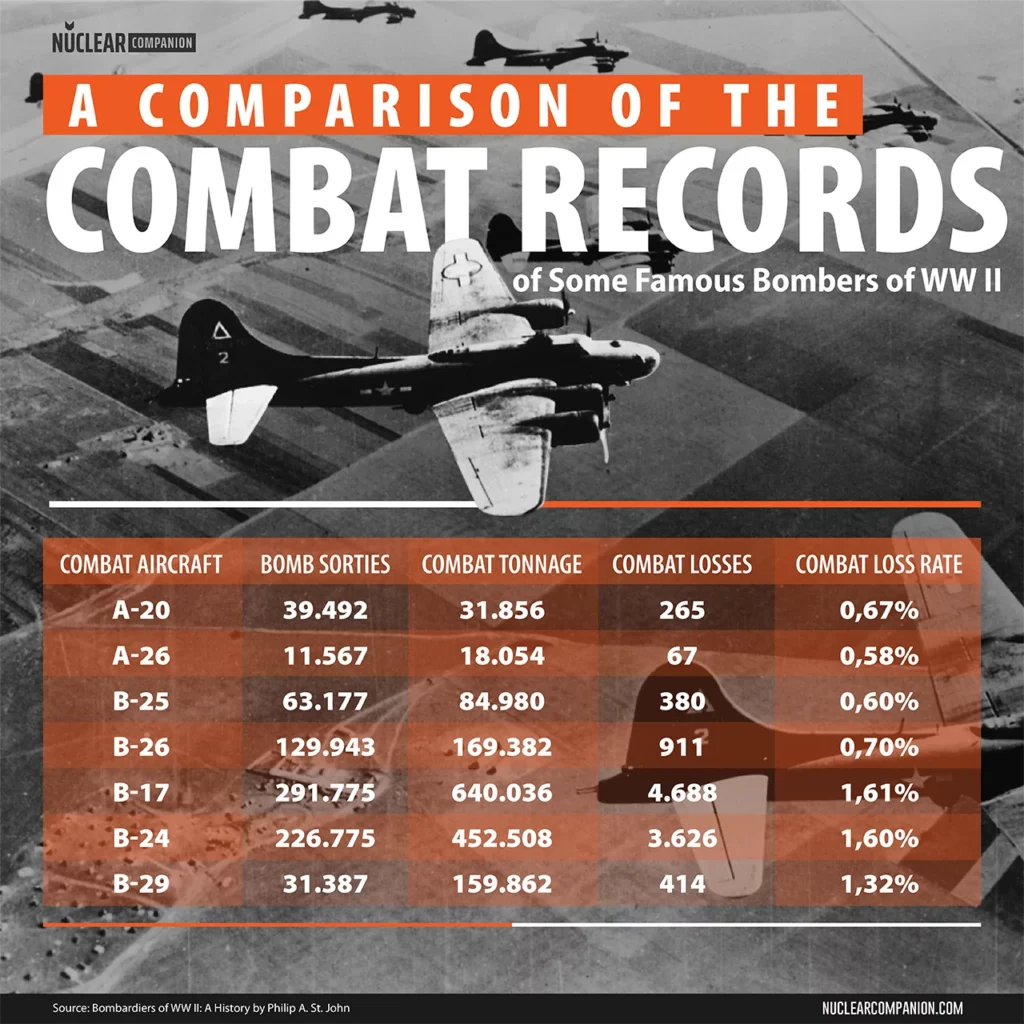
Taking measurements into account, a standard B-29 was a third longer and twice as heavy as a Boeing B-17 Flying Fortress.
Further reading
2) The B-29 was the most expensive weapon developed during World War II.
If we consider two things about the B-29:
- The B-29 was the largest and most complex aircraft yet built. Exactly. To build it we would need 27,000 pounds of sheet aluminum, over 1,000 pounds of copper, 600,000 rivets, 9 1/2 miles of wiring, and 2 miles of pipes. And let’s not forget 33,065 man-hours.
- The Superfortress was built in large numbers. 3,943 B-29s were produced in World War II and 5,092 were canceled when the war ended.
Initial costs per aircraft in a production run are high. But, as production techniques and assembly workers get more efficient, the cost per unit lowers.
According to William Wolf in his book Boeing B-29 Superfortress: The Ultimate Look: From Drawing Board to VJ-Day:
- An early production, a B-29-40-BA, cost $ 971,373
- A late production, B-29-90-BW, was listed at $ 495,780
That gives us, according to Wolf, a B-29 production cost of 3,7 billion dollars ($60,8 billion in 2021 dollars, Amazing!)
To put it in perspective, World War II cost the U.S. approximately 354 billion in 1945 dollars
Comparison with The Manhattan Project cost
The effort to produce the first Atomic bomb was an unprecedented research and manufacturing program.
The Manhattan Project was among the greatest achievements of organized human effort in history, comparable to the building of the Pyramids and the Great Wall in China. In a little under three years, an industry greater in scope and complexity than any single contemporary private industrial complex was built.
And according to Kevin O’Neill in Atomic Audit: The Costs and Consequences of U.S. Nuclear Weapons Since 1940, the Manhattan project’s total cost was 2,2 billion in 1945 dollars. That is less than the total cost of production of the B-29.
If you are interested in a deeper analysis of the costs of development, production, and operation of the B-29, we recommend you read our article How much did the Boeing B-29 Superfortress cost?
Further reading
3) The B-29 was the first combat aircraft designed to fight fully pressurized
One of many innovations featured by the B-29 was pressurized crew compartments. These allowed the crew to fly to targets in shirtsleeve conditions significantly reducing crew fatigue.
Altitudes problem
At high altitudes, two difficult and different problems are present that can reduce the crew’s efficiency or kill it:
Problem #1: Anoxia, or lack of oxygen. At altitudes of 10,000 feet and above, the air pressure is insufficient to drive enough air into the lungs to provide the body with necessary oxygen; this deficiency causes lethargy, severe exhaustion, unconsciousness, and eventually death.
Problem #2: Aeroembolism, also known as aviator’s bends. Nitrogen and oxygen both dissolve in the blood at sea-level pressure. While oxygen continues to be absorbed when the pressure drops at high altitudes, nitrogen is released as bubbles that might clog a vein and obstruct the blood vessel. This produces severe pain and might lead to irreparable damage.

A little of History
Aeronautical engineers have long been experimenting with pressurized cabins as a way to combat anoxia and bends.
Before the invention of the pressurized cabin, oxygen masks were the sole means of high-altitude flight. The B-17 crews utilized them well on brief flights, but on lengthy ones, the heavy equipment and prolonged oxygen breathing reduced the men’s effectiveness.
In 1938 the Army Air Corps had asked Boeing to work on a pressurized version of the B-17 but Boeing’s engineers after preliminary studies determined that it would not be feasible.
Previously, in 1935, Boeing successfully pressurized the 307 Stratoliner, the first pressurized commercial airliner ever built. The 307 was based on the B-17C (wings, tail, undercarriage, and engines) but used a new circular pressurized fuselage designed for that purpose.
B-29 pressurization
For the B-29, Boeing incorporated many of the 307 Stratoliner features and the fuselage was again designed to simplify pressurization. Continuing the trend, circular sections were used for holding pressure rather than an oval fuselage. The reason is simple: a perfect circle maintains its shape under pressure.
While the entire cabin was pressurized in the Stratoliner, three out of five compartments in the B-29 were pressurized.
- 1) Forward pressurized compartment or cockpit area. Most of the crew had positions here.
- 2) The rear pressurized compartment. It housed the gunners and the radar operator.
- 3) Tail gunner’s compartment. This was a small cabin for the tail gunner and he was isolated there.
A tunnel, 34 inches in diameter, passing over the two bomb bays linked the forward and rear compartments. This was Boeing’s solution to avoid pressurizing the bomb bays. Also, during long flights, the crew used the tunnel to rest and stretch out.
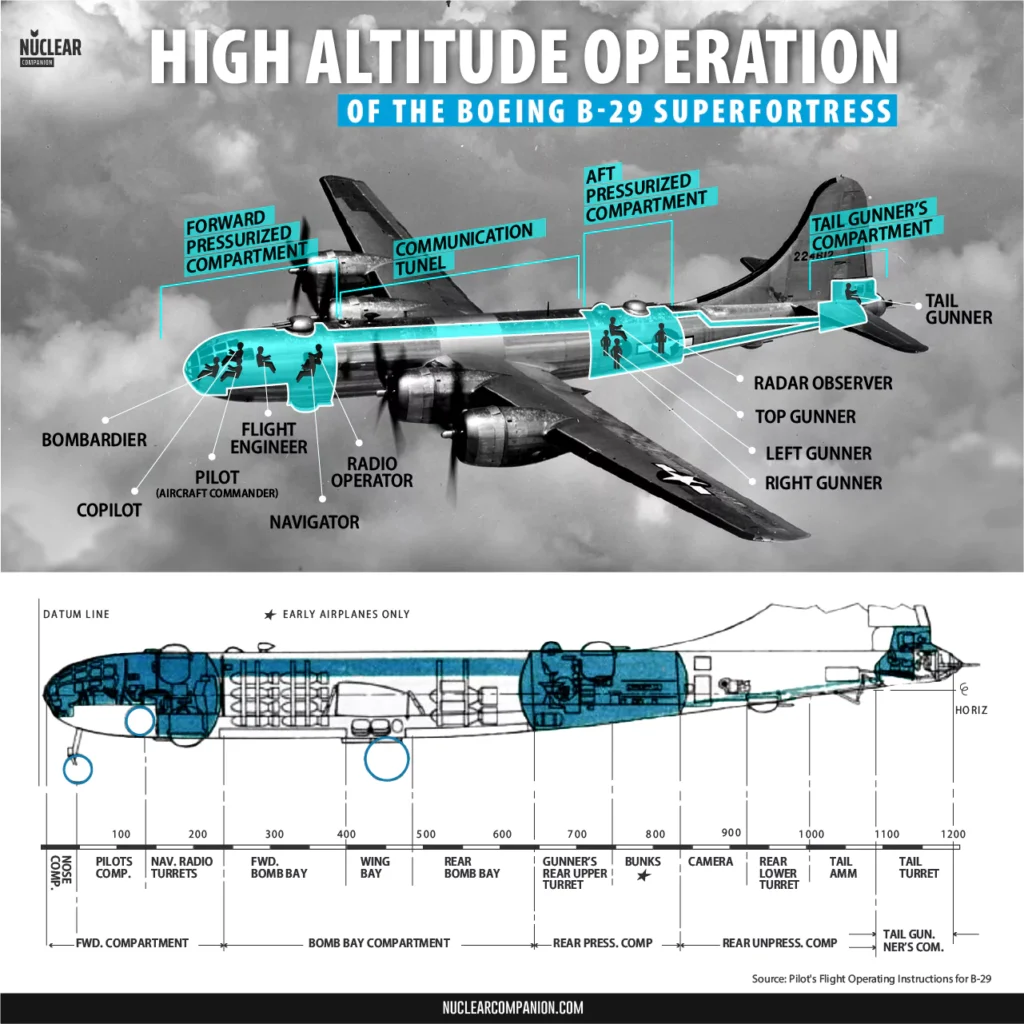
On the other hand, the tail gunner was separated by a pressure bulkhead door that he could open to access the other compartments.
How it worked
AirResearch Manufacturing Co. created and produced the automatic cabin pressurization system installed in the B-29.
The supercharger on each inboard engine produced compressed air which was supplied by ducts into the cabins. On the rear pressurized compartment, two regulators automatically controlled the internal pressure of the cabins.
- From sea level to an altitude of 8,000 feet ventilation was just provided. All extra pressure escaped.
- From 8,000 feet to 30,000 feet, the regulators maintained a constant 8,000-foot altitude pressure inside the cabin.
- From 30,000 feet the “floor” pressure started to rise with altitude. E.g. 10,000-foot altitude pressure inside the cabin at 34,000 feet.
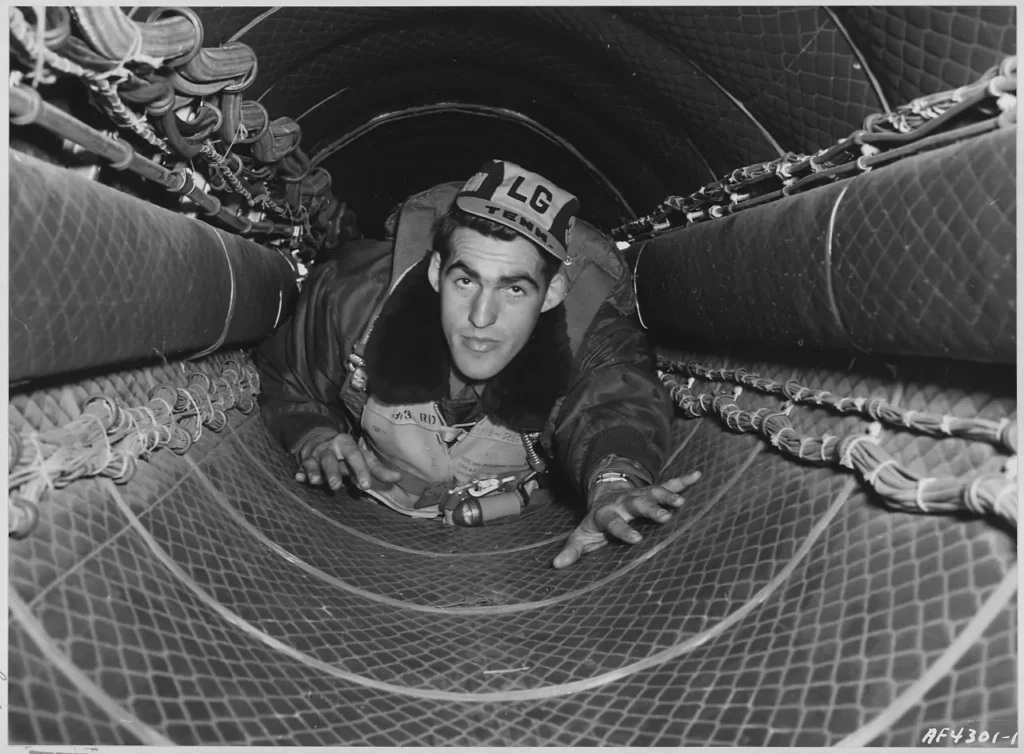
Gasoline-operated heaters provided heat to the cabins and were controlled automatically by a thermostat.
Into Battle
During combat, enemy flak and fighters could open a hole and depressurize the cabin. Then, the crew had to struggle into their emergency oxygen masks and heated high-altitude suits.
To avoid the loss of efficacy of the crew during that critical moment of the mission(close to the target), the B-29 was depressurized before it entered the zone of active combat.
During the action, the crew was on oxygen masks and heated suits. Later, for the long flight back to base, the B-29 could be pressurized again.
The crew could also during flight patch the bullet holes caused by battle damage using a technique developed by Boeing.
4) The B-29 had the largest engine installed yet in an aircraft but it was the B-29’s Achilles heel
At the time the B-29 left the factory, its engine became the largest a plane had ever had. The Wright R-3350 Duplex Cyclone was 55 inches high and 76 inches wide and had a dry weight of 2,595 pounds.
To put things in perspective, the engine in the four-engined B-17, the Wright R-1280-97, had 1,200 horsepower and nine cylinders. The R-3350, in turn, had 2,200 horsepower and a twin row of 18 air-cooled cylinders. This hardware allowed the B-29 to draw large air masses as no other aircraft could.
Such capacity was there from the beginning. Wright’s original idea was to create an engine with a horsepower per pound.
The design process started in Jan. 1936. Nearly ten years later, the R-3350 joined the war, after going through around 48,500 technical modifications.
However, these fixes were not enough.
During the time Wright was working on the R-3350, it was also developing and producing other important engines, like the B-17’s R-1820s. So busy, Wright engineers had little time to focus on the R-3350.

Consequently, as the B-29 was rushed into the frontline, its design flaws came to light.
The R-3350 would prove its worth in subsequent large piston-engined planes, including civilian aircraft. However, during its early days, the R-3350 was a constant source of headaches for the B-29s’ crews. In fact, more B-29s succumbed to engine problems than to the enemy.
And while different components were at fault, it all went down to a single problem: overheating. The R-3350 lacked enough airflow to cool down its cylinders, a problem inherited from the XB-29 prototype.
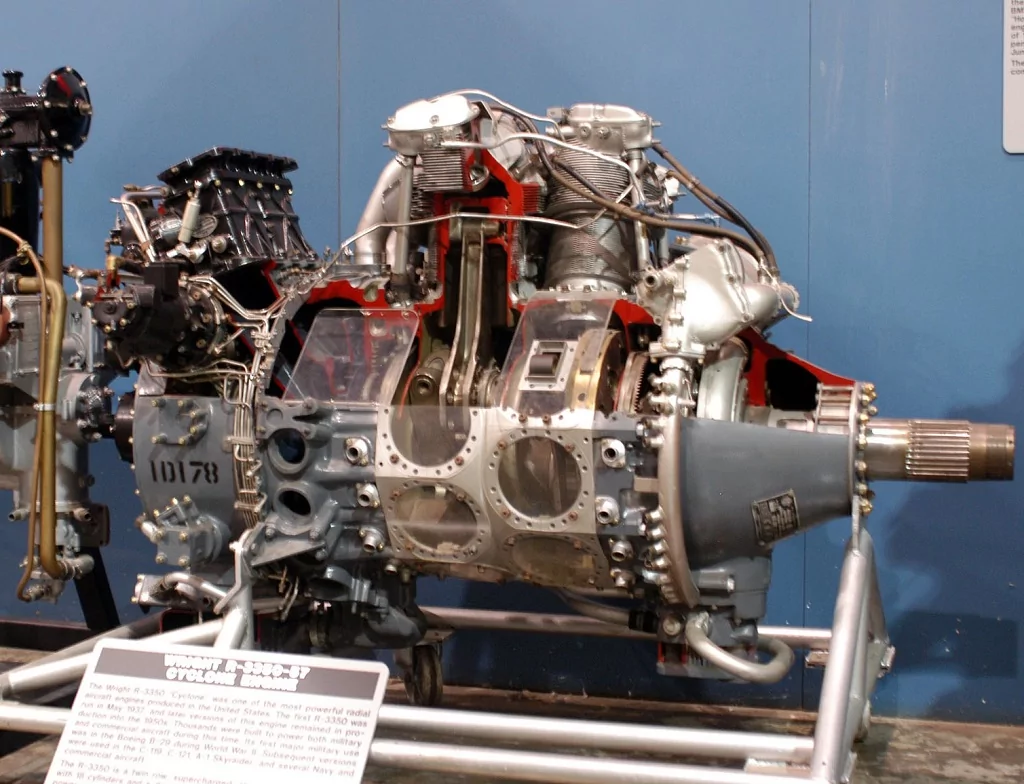
The hot and humid destinies in which it saw action (China Burma India Theater and the Pacific) didn’t help either. There, ground temperatures can go over 120 F, above the minimum air temperature for the engine’s carburetor to work properly.
As such, the engine’s cylinder overheated, the oil burned its valves, and the whole engine started to burn. And when one of these R-3350 caught fire, it wasn’t easy to put out—if not impossible.
The R-3350’s magnesium crankcase, designed to make the engine lighter, was the culprit.
The crankcase’s design was far from perfect; while strong, combat loads vibrations were enough for cracking it. But the worst part was the magnesium, whose flames can reach 5,600 F and burn even in water. In numbers, 87% of the time a B-29’s engine caught fire, the aircraft extinguishers just weren’t enough.

Engines suffered from heat and fire, but also propellers. Overspeeding, these came off and disintegrated, damaging the aircraft’s fuselage in the process.
To make things worse, the B-29’s cowling —designed by Boeing to favor aerodynamics— was too close to the engine. Also, the cowl flaps, when opened to cool the engine down, made the aircraft flutter and vibrate. Crews had to rely on them at their own risk.
The cowl flaps were crucial for taking off when the four engines had to be simultaneously at full power. If a single one of them failed, it was equal to crashing.
B-29 tail gunner Andy Doty of the 19th Bomb Group recalls the image of taking off and watching, at the end of the runway, destroyed B-29s that didn’t make it. In a way, their own aircraft was more intimidating to crewmembers than the enemy.
Testimonies like his are part of the founded distrust of the B-29 in its early days. However, Wright continued developing the R-3350. The cowling and cowl flaps were changed, its induction system was improved, and the overheating was solved.
Further reading
- Wright R-3350 Duplex Cyclone technical specification
- Boeing B-29’s Wright R-3350 engine variants table
5) The B-29 was equipped with the world’s most advanced remote-controlled turret fire–control system
The B-29 defensive armament was out of this world compared to other World War 2 bombers. The system was called the General Electric Central Fire Control (CFC) System. In simple words, a central control station that allowed gunners to remotely control machine guns.
This truly revolutionary system allowed the B-29 gunners to:
- tracking incoming fighters with greater accuracy
- open fire at greater ranges (maximum range of 1,500 yards, with an effective range of 900 yards)
- to control multiple turrets at the same time
- arrive over the target fresh and ready for action thanks to flying in a pressurized environment.
It also, made it possible for the B-29 to fly unescorted bombing missions against Japan.
The B-29 was fitted with five defensive turrets. Four of these were General Electric (GE) remote-controlled turrets (upper forward, lower forward, upper rear, lower rear) and the fifth was a single manned tail turret.
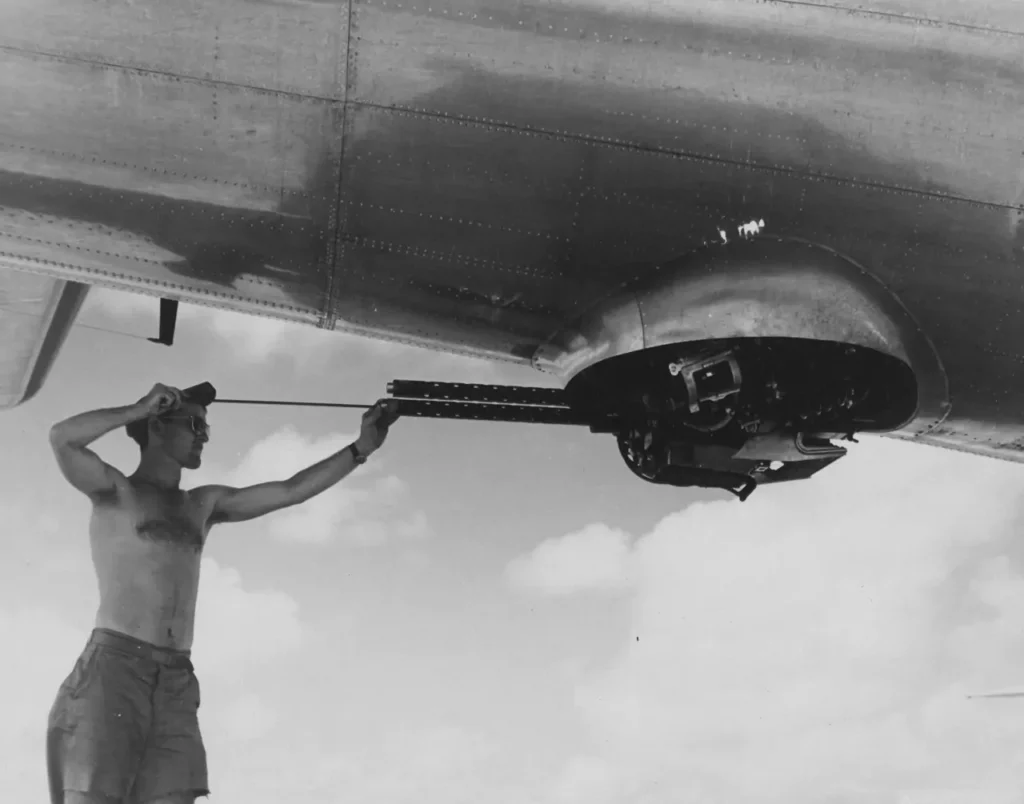
The tail turret was equipped with two .50cal machine guns and a 20mm cannon and was the only crewed gun station.
The GE turrets were streamlined, stationary, and non-retractable with two .50cal machine guns. Due to being unmanned, these turrets were smaller, imposed less drag, and were positioned in more effective positions.
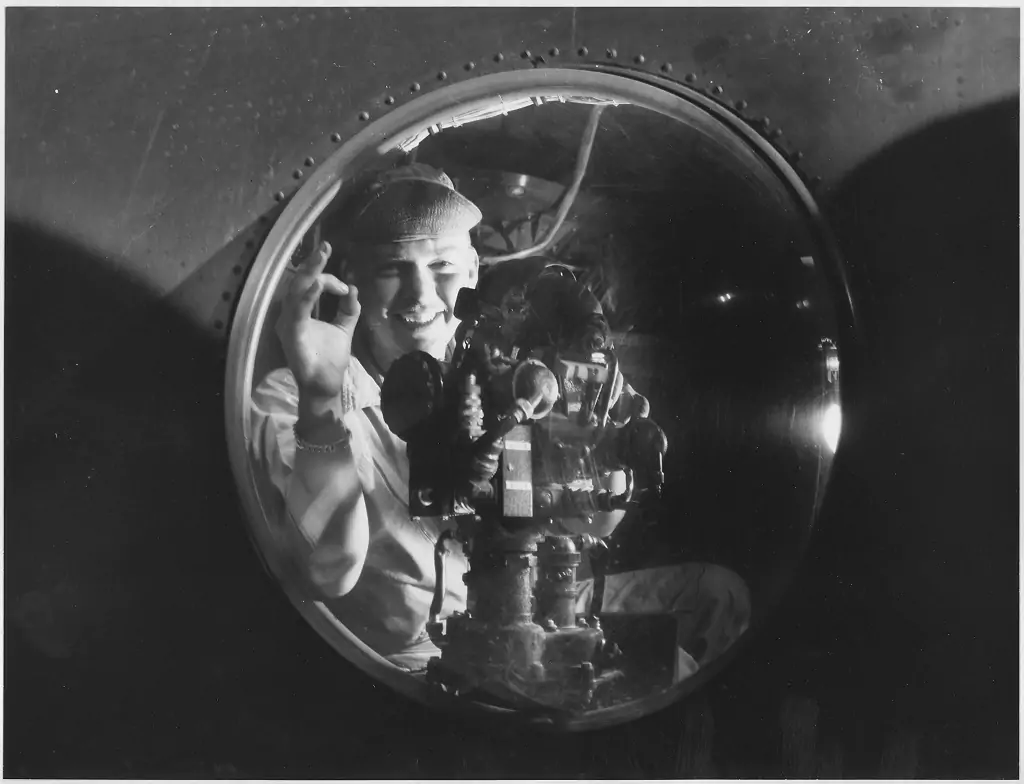
The gunners for these turrets were seated in sight stations (plexiglass blisters on the sides of the fuselage) and remotely controlled them. As mentioned before, control of the turrets could be transferred between gunners.
Each individual gunner had primary control of a certain turret and secondary control of others.

A gunner could assume control of another turret in case of
- He needed more firepower
- Another gunner became incapacitated
- Another gunner did not have a good line of sight over a target
In addition, the four remote-controlled turrets were connected to four 50lbs electro-mechanical analog computers. These computers, built at General Electric’s Erie plant, calculated corrections for several factors and allowed gunners to accurately fire at enemy fighters.
The B-17 experience
Let’s imagine that we are a waist gunner flying a B-17 at a high altitude. One could think that our worst enemies were fighters but it was the Cold. indeed, it was flying in cold storage.
To target the fighters, you had to open a big side door and fight through a 200-mile-per-hour gale. And don’t forget you’re at 30,000 feet and in oxygen with a temperature of about 60 degrees below zero with frost forming right over your eyes.
In this intense cold, handguns often froze up and could not move and even the mechanisms of weapons would freeze up and become useless. Electric-powered turrets were needed.
Rush to combat
The rush to get the B‑29 into combat in 1944 made the first batch of analog computers to be in poor condition.
During March and April 1944, the USAAF pushed to get the B-29 Superfortress in the air. For that, workers completed 16- and 24-hour shifts each day correcting the mistakes made on the assembly line. This was known as the “Battle of Kansas”.
Despite this, the CFC system did not always work as expected.
In addition, there were not just mechanical problems but also a lack of full training. Indeed, the CFC system was difficult to master and the shortage of Superfortresses for training didn’t help.
WW2 combat performance
According to the USAAF, it recorded 11,206 fighter attacks against the B‑29. Of those, B-29s claimed 914 fighters were shot down, 456 were probably destroyed and 770 were damaged.
However, when Maj Gen Curtiss LeMay changed to low-altitude night missions at the beginning of 1945, the B-29s were stripped from their armament to increase their carrying capacity.
In fact, a new version was designated B-29B, and its only defensive armament was the tail gun. Bell produced 311 of these B-29Bs.
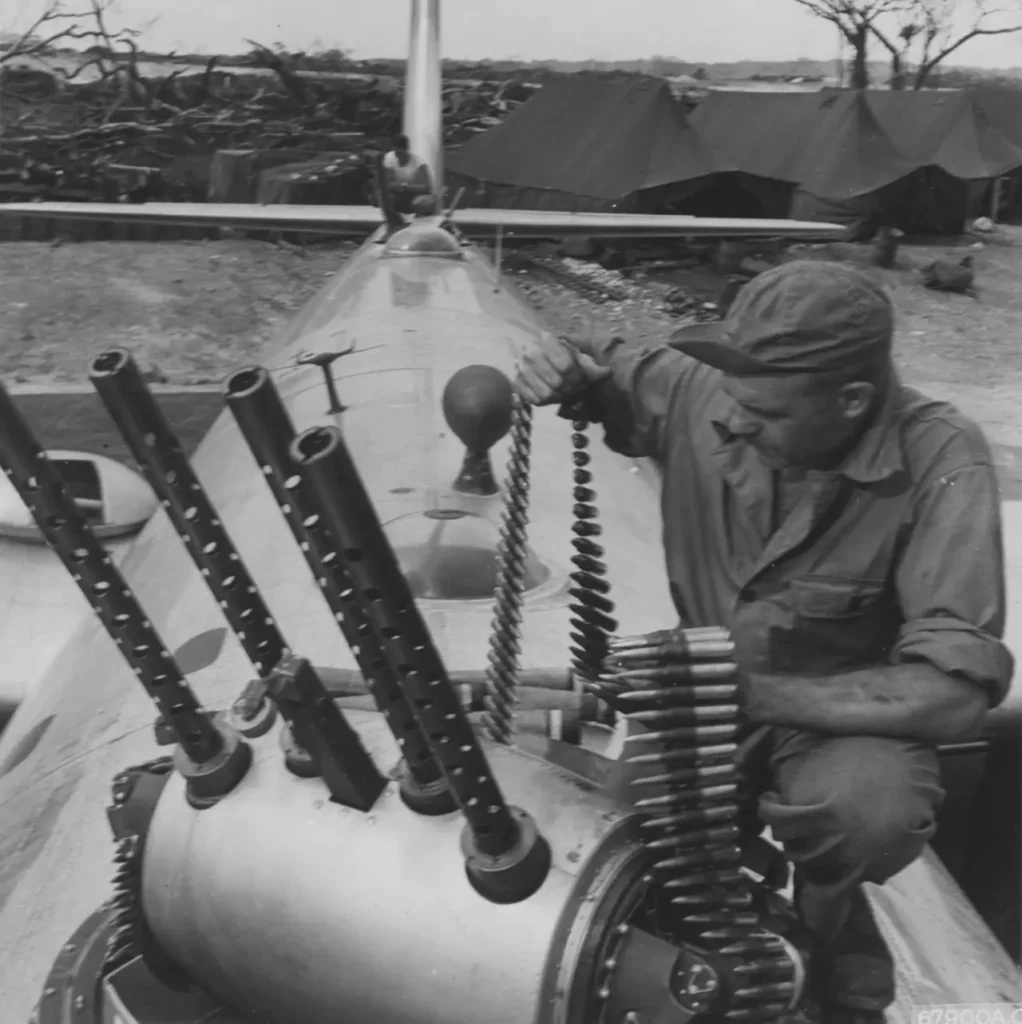
The CFC in Korea
During Korea, CFC Gunners faced a new and far deadlier enemy than Japan’s Ki‑44: The MIG-15 jet fighter.
When appeared in Korea in November 1950 it was one of the world’s most advanced production aircraft. Due to its velocity and heavy armament, it really endangered the B-29.
B-29 gunsights would have to track the Mig-15 almost as twice as fast as the old Ki-44. Despite that, CFC Gunners claimed 16 MiG‑15s shot down
6) An unknown foe made the b-29 struggle and almost fail its bombing campaign in Japan
World War II’s most expensive weapon, the B-29, was late for Europe, but not for Japan. Thanks to its exceptional autonomy, it could fly past enemy lines for long-distance operations. If the U.S. Air Force could reach strategic targets earlier, it would have the upper hand in the Pacific.
The person calling the shots was Major General Haywood Hansell Jr., in charge of the XXI Bomber Command unit based in the Mariana Islands. To his understanding, the B-29 was perfect for precision bombarding. Flying at high altitudes, the Japanese defenses would have a hard time fighting against them.

Japan’s jet streams
However, flying at high altitudes wasn’t gonna work in this scenario. Japan had a hard counter prepared for it, or better said, its climate had. And since neither the U.S. Air Force (nor the Japanese) had conducted military operations at such height, jet streams were a surprise for both of them.
Colloquially speaking, jet streams are air rivers resulting from the coalition of warm and cold air masses. Large temperature differences fuel the jet stream’s speed, some reaching 250 mph (or 412 km/h).
On Nov. 24, 1944, more than a hundred B-29s, loaded with 300 tons of explosives, took off from Saipan and headed towards Tokyo industrial facilities. Nakajima’s Musashino plant, an aircraft engine factory, was their main target.
Flying at more than 27,000 ft from the ground, the B-29s met with Japan’s jet streams. Unable to maneuver properly, most bombs missed their targets entirely and the factory was barely damaged.
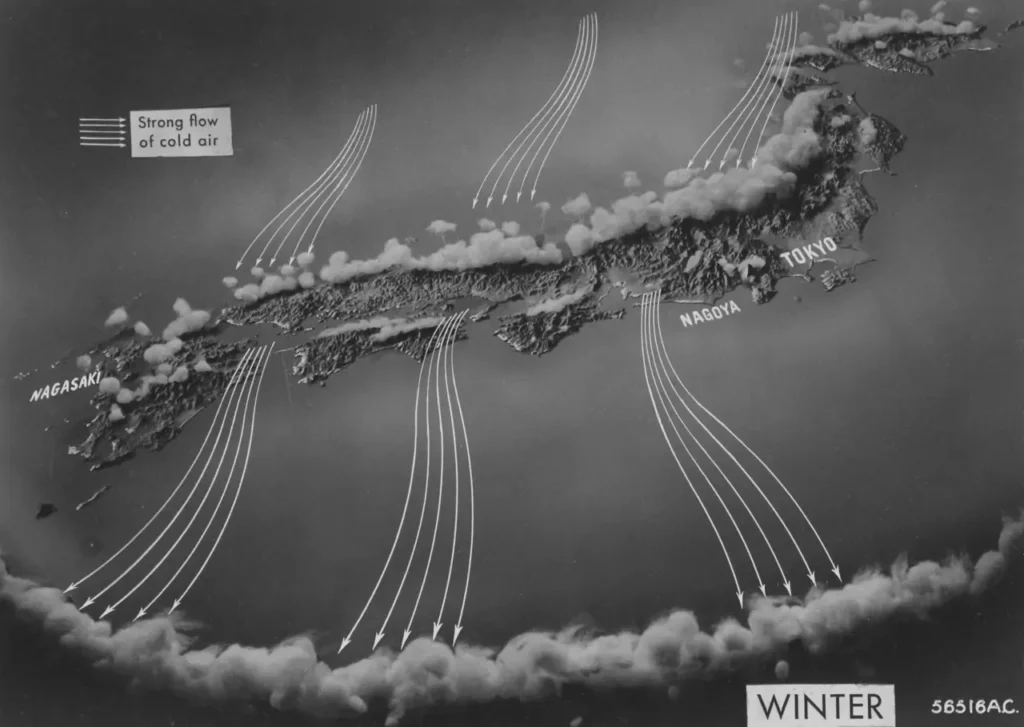
Time after time, jet streams made it impossible for B-29s to fly in combat formation and aim properly for droppings. The U.S. Air Force learned the hard way that the whole operation was in jeopardy.
Failure was far from what was expected of the Superfortress aircraft. By the beginning of 1945, the bomber was still to prove its worth.
Yet Hansell insisted on precision bombarding. On Jan. 19, a mission of his destroyed almost entirely an aircraft factory at Akashi. Ironically, the news of the damage only reached his compatriots much later. The overall situation forced the U.S. Air Force to remove Hansell from his position and replace him with Curtis LeMay.
LeMay’s radical new strategy
LeMay, for his part, saw in strategic bombardments the right approach for taking Japan out of the war. He chose to drop mines from bombarders in Japanese seaways and ports to halt the country’s maritime traffic.
LeMay also abandoned daytime incendiary attacks from high altitudes. Instead, he ordered daytime incendiary and precision bombing from 5,000 to 10,000 ft. to avoid jet streams.

For carrying more bombs, LeMay took out most of the defensive ammunition of the B-29s. To his understanding, Japanese night fighters weren’t as dangerous as they initially thought. Besides, ground defense systems still expected B-29s at high altitudes and weren’t ready for targets flying lower.
The result of LeMay’s changes was the destruction of four major Japanese cities in five raids. During the following months, LeMay continued using B-29s for mining Japan’s military capacity and civil life.
Further reading
7) The B-29 fire-bombing campaign devastated Japanese cities and destroyed the ability of Japan to fight.
The two atomic bombs dropped on Japan are popularly acknowledged as what took the country out of combat. However, prior to that, and even before the Soviets began to attack Japanese positions, the Land of the Rising Sun was already in ruins.
The B-29 was behind this destruction, leaving Japan unable to repel the Allies.
More than the Atomics bombs
Curtis LeMay, in front of the Twentieth Air Force and its XX and XXI Bomber Command units, set a perfect example of how to win a war while presiding from a ground invasion. And while there isn’t consensus on whether or not his bombing campaign would have been enough for Japan to surrender formally, its effects were tangible.
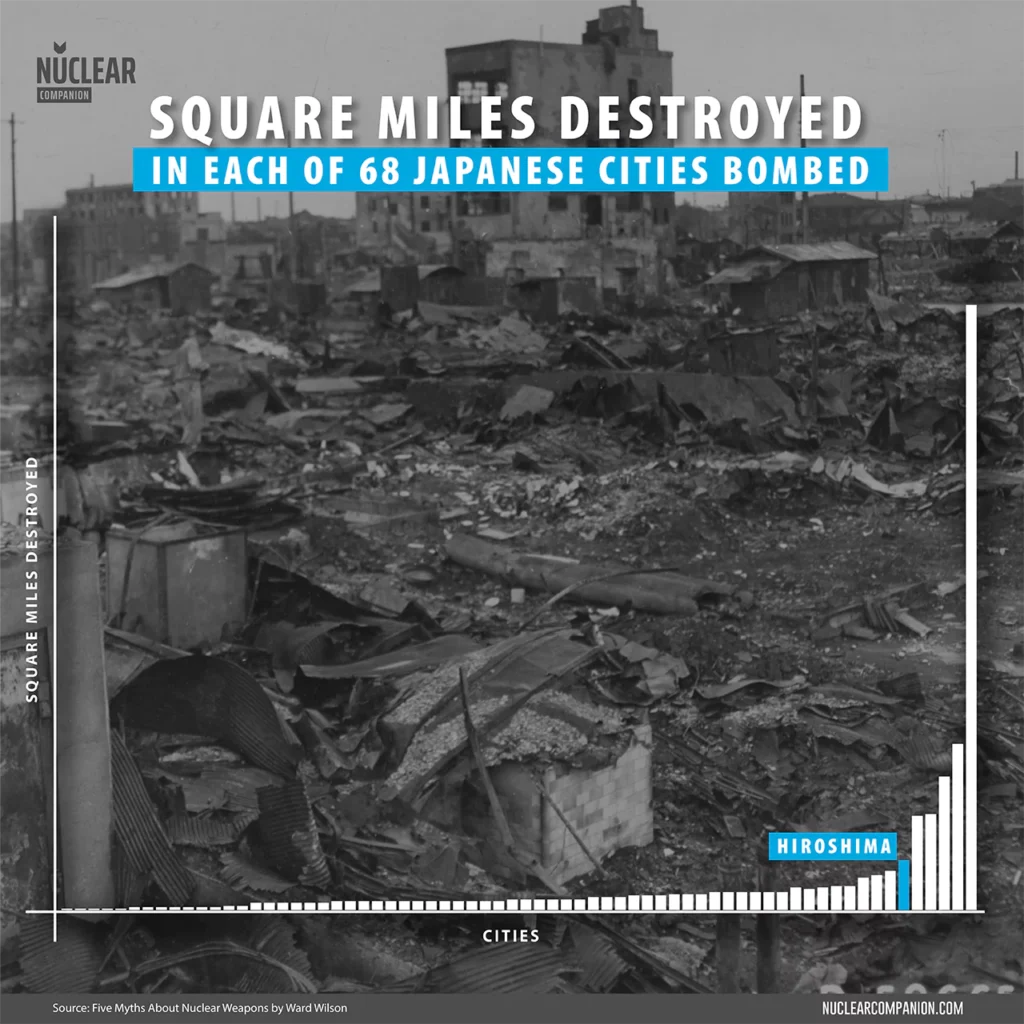
The strategic bombing campaign destroyed a total of 67 Japanese large cities. To put things in perspective, the explosion of both nuclear bombs covered 7 sq mi, while 170 sq mi of Japan’s urban area was attacked during LeMay’s bombing campaign.
According to the US Strategic Bombing Survey, The bombing destroyed 2.51 million houses. 30% of all Japanese living in cities lost their homes, not to mention those who lost all their possessions.

As a result of the bombing campaign, 6 million people had to evacuate. 330k civilians died and 476k were wounded, surpassing the 780k military losses.
Destroying the Japanese Industry
LeMay’s strategy consisted of halting Japan’s industry, and also, its raw materials and food supply chains. This couldn’t have been possible without the B-29’s unique technology.
The other four-engine bombers used in Europe —the B-17, B-24, and Avro Lancaster— were unable to reach Japanese industry key targets. Taking off from Okinawa, these aircraft couldn’t reach targets in northern Kyushu or Shikoku islands, in southern Japan. Therefore, Tokyo and Nagoya were out of the question.
But the B-29 could reach any point of Honshu, Japan’s main island, thanks to which it was able to freely bomb northernmost targets, including the Tsuchizaki’s oil refinery and cities like Aomori.
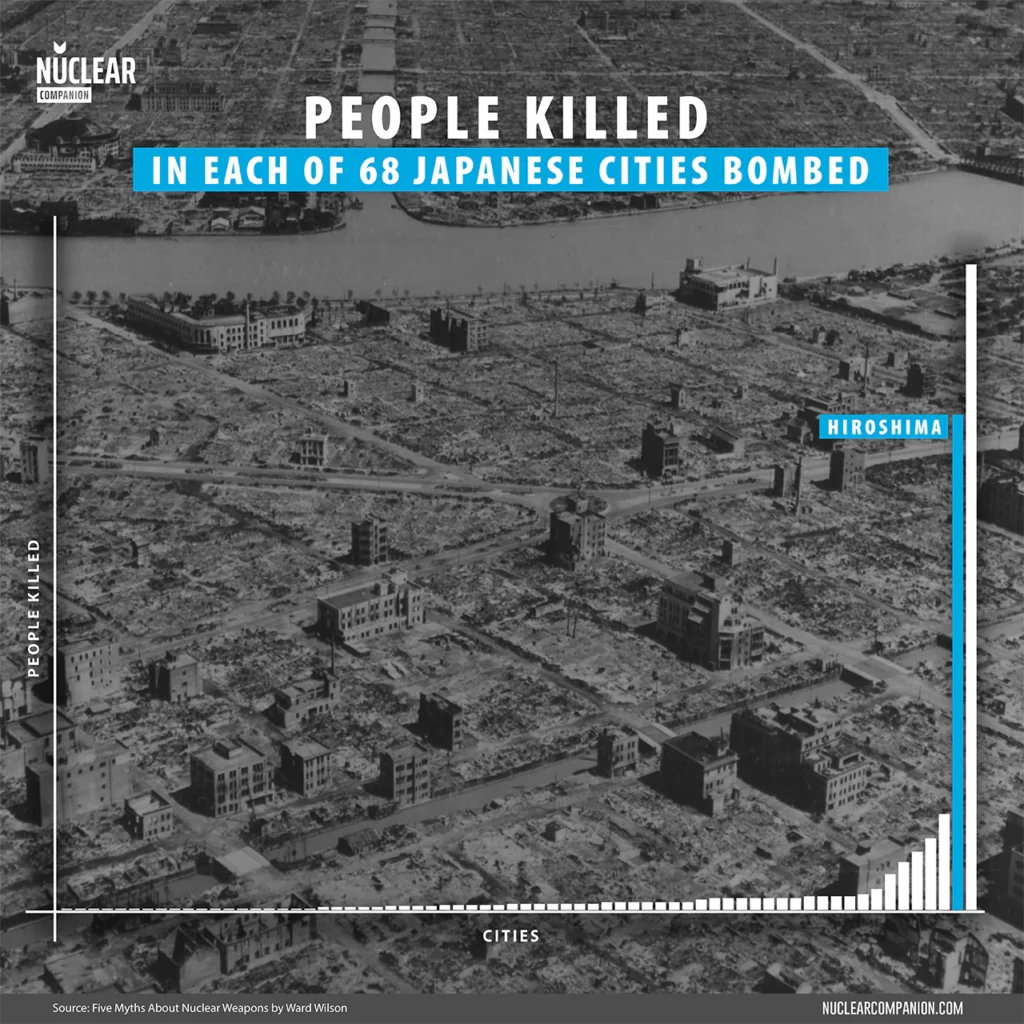
Soon enough, the Japanese aircraft industry and arsenal crumbled. Japan’s aircraft production peaked in Jul. 1944, just a month after the first B-29’s bombing on its soil —with the former city of Yawata as the target—, but a year later, production had dropped by 60%.
So it did ammunition production. Due to the lack of imported goods, ordnance production dropped by 18% from Aug. 1944 to Mar. 1945, and by Jul, it could merely output 40% of what was produced in Mar.
Similarly, shipbuilding production dropped to a quarter of its peak between Mar. and Aug.
By then, little remained of Japan’s industrial base, and its factories and mills were short of raw materials. Phosphate and nitronate, used for fertilizers, had to be used for war materials.
Food supply and aerial mining
But even if Japan’s industry could have continued working, with its sea full of mines the country would still have been unable to feed its population.
In 1941, a fifth of Japan’s food came from abroad. And yet, as the war continued, the country became more and more dependent on importing grains and beans from China and Korea. All the while, Japanese fishing ships, when not forced into the Imperial Navy, were sunk by the enemy.
Submarines destroyed 60% of the Japanese ships, while mining was mostly destined to destroy the country’s logistics. Mines were behind 63% of the destruction of Japanese merchant ships from their introduction until the end of the war.
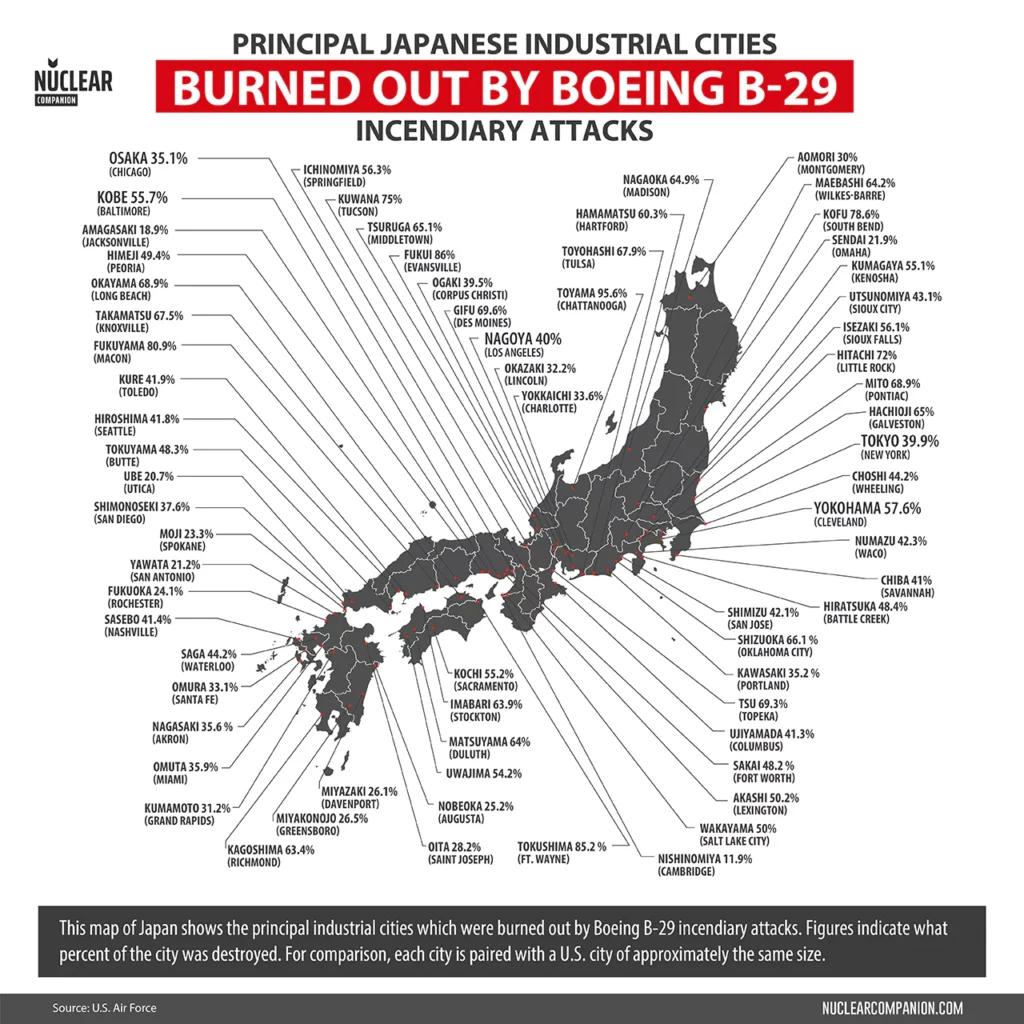
Losing 15 bombers during aerial mining, the B-29 unit destined 6% of its total tonnage for dropping around nine thousand tons of mines, twelve thousand of them. Half of these mines ended in the Shimonoseki Straits, which by Jun. 1945 saw its traffic reduced to 10% and by Aug to only 2%.
Let’s consider that even in peacetime the country had problems with its food supply. In terms of average caloric intake, its population was barely above 6.4% bare subsistence levels, so it was fragile enough without the setback of facing Curtis LeMay’s heterodox mining.
Adding to mining, the B-29’s incendiary attacks destroyed a quarter of Japan’s food supply.
Aside from food, electronic devices, clothes, and overall chemical production stopped. Without refining plants, fuel production stopped as well.
8) The Soviet Union copied the B-29 as the Tupolev Tu-4
In 1944, the Soviet Union began the development of a bomber with a role and capabilities similar to the Boeing B-29. The State Defense Committee ordered four design firms to participate in what would be called the “Flying Fortress Contest”.
The 4 design bureaus were OKB-156 of A.N. Tupolev, OKB-482 of Vladimir M. Myasishchev, OKB-22, headed by I. F. Nezval and Sergey V. Ilyushin’s OKB-240
However, by 1945 it was already obvious that the development of an indigenous B-29, with production techniques, materials, and equipment that were available in the Soviet Union, would be very difficult. Modern equipment (navigation and radio equipment and the automated remote control system) were the most difficult to achieve.
This would mean that the Soviet Union would be left without a bomber capable of carrying the atomic bomb.
But, Why not just copy the b-29? This was now possible since three examples of the B-29 had been impounded in the Soviet Far East.
Well, according to some accounts, it was a Marshal, Aleksandr Ye. Golovanov, who dared to approach Stalin with this proposal. But, according to another account, it was Vladimir M. Myasishchev’s idea.
A challenging task
The truth is that on June 22, 1945, Tupolev and Vasily A. Okulov (Director of Aircraft Factory No. 22) were commissioned to produce a copy of the B-29 called B-4.

The three captured B-29 bombers were flown to Moscow. One was used for study, another for dismantling and copying, and the third as pattern aircraft.
Copying the B-29 would not be an easy task either.
Some 900 enterprises and organizations were involved in work on the new aircraft, some of them brought back into being specifically for that purpose. The effort required companies from a wide range of specialties. Metallurgic, for creating structural materials, electrical and chemical to create wires with reliable insulation.
But, less than two years after work on the project began, Tu-4 ‘s first flight took on 19th May 1947 captained by test pilot Nikolay S. Rybko.
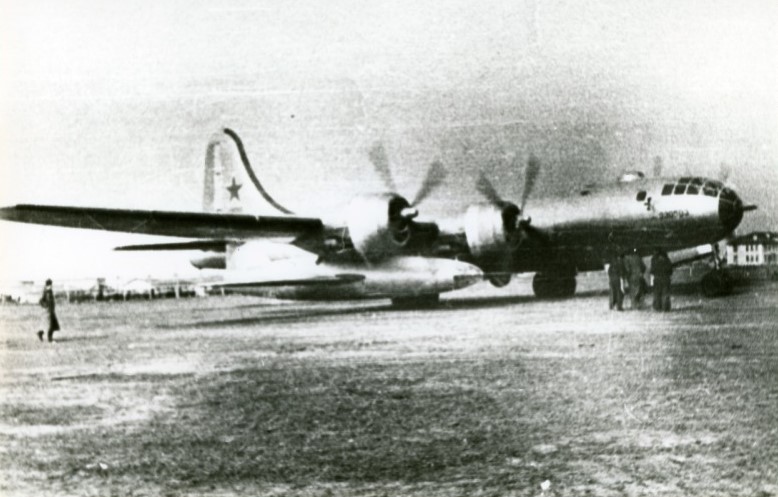
The west in panic
The decision to copy the B-29 proved to be a wise move for the Soviet Union.
The Tu-4 moved Soviet aviation technology to a new, “Western” level. It opened the USSR to equip its aircraft with high-altitude engines, turbochargers, pressurized cabins, onboard radio location, navigation, and bombing systems, remote-controlled weapon systems, new alloys, and synthetic materials.
For the U.S. and its allies, it was surprise and panic. The Tu-4 possessed sufficient range to attack Chicago, Los Angeles, and New York on a one-way suicide mission. The development of the Soviet Atomic Bomb in 1949 made it worse since the United States was now in danger of a nuclear attack

Tu-4 Derivatives
From there, the Tu-4 was mostly produced as a standard bomber. Several were converted to nuclear-bomb carriers, and missile carriers armed with anti-shipping cruise missiles.
The Tu-4 served as a basis for various special mission aircraft with some having no direct U.S. equivalent: flying testbeds, long reconnaissance, aerial film shooting, airborne command posts, transport, tankers for air refueling, trainers, etc.
Most important, the Tu-4 gave birth to a whole family of Soviet Strategic Bombers. It led to the jet Tu-16 and prop Tu-95 bombers. The last one became the backbone of Soviet Strategic Aviation.
From 1954 onwards the Tu-4 was gradually supplanted by the Tu-16 and from 1956 onwards the Tu-95. The Tu-4 remained in service until the early 1960s.
A few Tu-4s had been provided to China; by 1991 no fewer than 15 Tu-4s were listed in the People’s Liberation Army Air Force (PLAAF) inventory.
Further reading
9) During the early 50s, the B-29 was reengineered as the B-50 and converted into America’s primary atomic strike bomber
Not only did the Boeing B-29 Superfortress survive World War 2, but it was revisioned, upgraded, and formed the backbone of the U.S. Air Force’s nuclear deterrent program in the first years of the Cold War.
In July 1944, a contract was awarded to Pratt & Whitney to test a production B-29 using more powerful R-4360 Wasp Major engines. This modified unit was designated XB-44 and was used to gather preliminary data.
The XB-44 flew for the first time in May 1945 and It was about 50 to 60 mph faster than a production B-29.
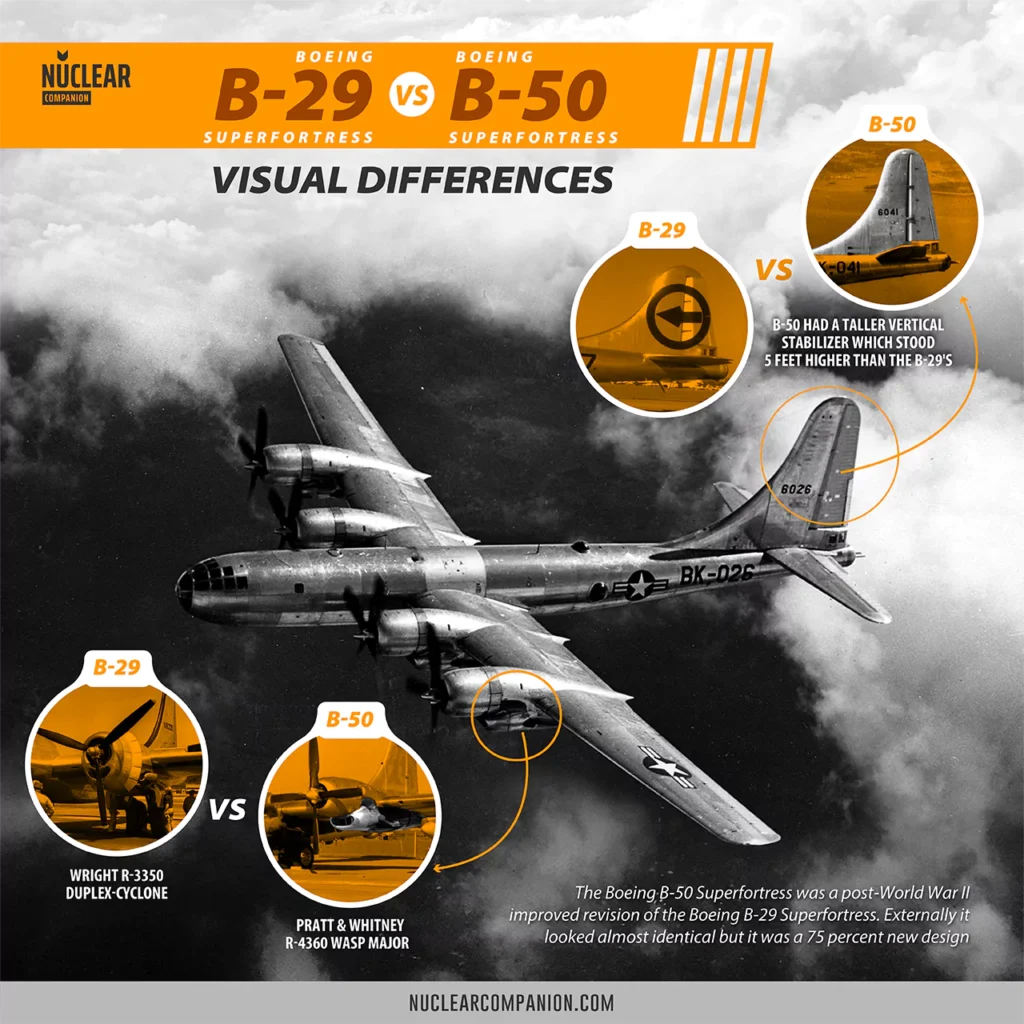
However, the XB-44 was just a proof of concept, and the B-29 needed more than an engine upgrade. The introduction of nuclear weapons forced that. Indeed, the B-29 airframe was not optimized for the delivery of these new heavy weapons. Also, the B-29 was marginally capable of escaping its detonation effects.
A complete revision of the B-29 was needed and its name was B-29D. Boeing included the following improvements:
- The R-4360 3,500HP engines with redesigned nacelles
- A new airframe that only shared merely 25% with original B-29s
- Lighter and stronger 75ST aluminum alloy for its structure and skin. It resulted in a 16 percent stronger wing but 600 pounds lighter.
- A taller vertical stabilizer which was the most obvious visual change
In July 1945, the U.S. Army Air Forces ordered 200 B-29D.
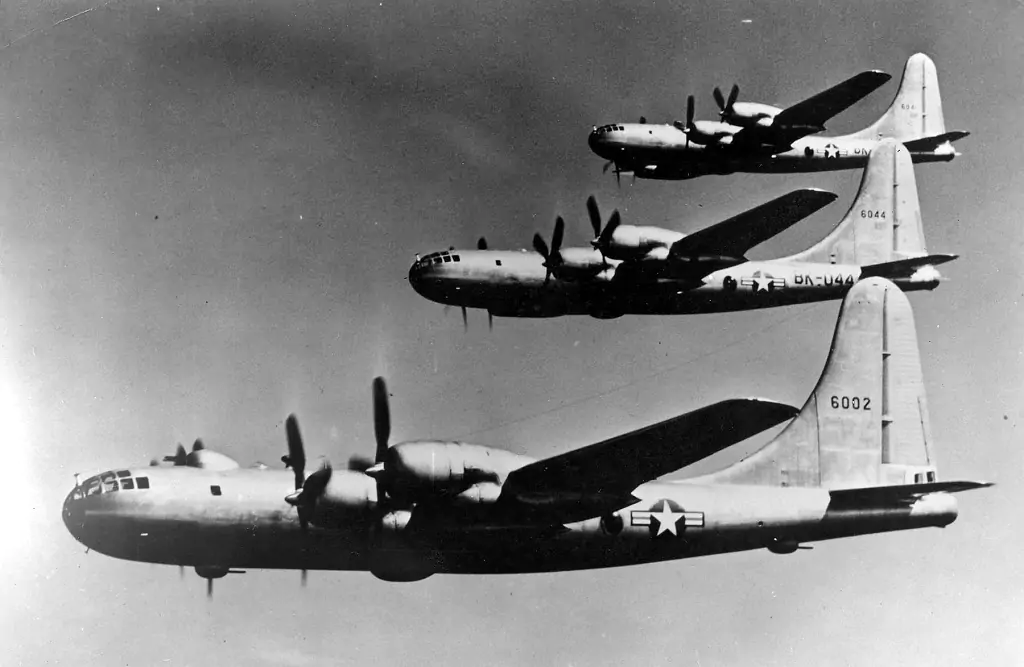
Yet, shortly after the war ended. Massive cancelations of weaponry followed as well, including 5,000 B-29s called off in Sep. 1945. The B-29D wouldn’t be the exception: just 60 of the original 200 B-29D orders remained in December 1945.
With thousands of B-29s being mothballed, it was really difficult to get funds for a new B-29 variant. Therefore, the B-29D was sold as a new aircraft: in December 1945, the B-29D became B-50A
The first B-50A flew in June 1947 and it entered Strategic Air Command’s inventory in February 1948.
B-50s were expected to leave the factory with native support for atomic weapons. However, the Atomic Energy Commission, manufacturer of nuclear bombs, was —for security reasons— unwilling to share the dimensions and weight of their weapons.
In this way, the B-50 could only be adapted to carry nuclear weapons once it had left the factory.
Several modification programs over 3 years prepared the new bomber for its nuclear role.
- Saddletree and On Top programs for making the bomber compatible with nuclear bombs Mark 3, 4, 5, 6, and 8.
- Winterization program for operations in Arctic bases.
- Superman and Ruralist for air-to-air refueling modifications
- Global Electronic Modification(GEM) for worldwide navigation and communication
Upon becoming an active aircraft, the B-50 became the U.S. Air Force’s primary nuclear bomber. Six Bombardment Wings, each one with 45 planes, converted to the B-50.
Lucky Lady II
In March 1949, the Lucky Lady II, a B-50A (s/n 46-010) made the first nonstop around-the-world flight. The bomber of the 43rd Bombardment Group made the flight from Carswell Air Force Base, Texas and It covered 23,452 miles in 94 hours and 1 minute. For such an endeavor, it was refueled four times in the air by KB-29 tankers of the 43rd Air Refueling Squadron.
But, SAC commanders had no illusions regarding their piston engine bombers. It actually was a stop-gap atomic bomber. They expected the B-50 and Convair B-36 to be obsolete by 1951 and so their jet replacements were already on their way
Indeed, the Boeing B-47 Stratojet medium bomber was the replacement for the B-50, and the Boeing B-52 Stratofortress heavy bomber was the one for the B-36.
However, the B-47 suffered from production problems and program modifications. Although the B-47 first flight was in December 1947, it became operational in 1952. Phased out of the B-50 started in 1953; by 1956 the B-47 had replaced it.

The last B-50 bomber, from the 97th Bomb Wing at Biggs AFB, was removed from the active nuclear force on 20 October 1955.
In the end, the B-50 in the atomic role served much longer than planned but it created the U.S.’s first truly creditable atomic deterrent in such a critical time.
Other variants of the B-50, for example, weather reconnaissance, atmospheric sampling, and tanker aircraft continued serving in other commands of the United States Air Force with the last B-50 being retired in 1967.
10) The B-29 was the first operational USAF Tanker
Once World War II was over, the U.S. Armed Forces underwent a restructuring process, from which the U.S. Army Air Forces wouldn’t be exempted.
To keep up with the new military technologies and worldwide geopolitical scenario, General Carl Spaatz concluded that all military assets involved in operating game-changer, and long-range weapons should work together as a single institution. The Strategic Air Command (SAC) was then created.
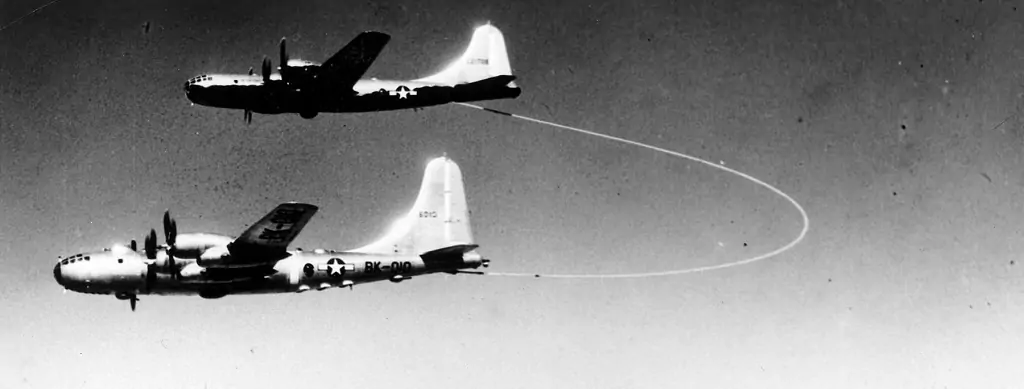
The U.S. Air Force’s bombers and transport planes were under the control of SAC, taking part in the Korean War with General George C. Kenney as head of the command. Among these bombers was the B-29, which, like the U.S. Army, had to transform and adapt to the upcoming times.
Meant to act as support for long-range operations, the KB-29Ms, the first operational tankers, were modified B-29s featuring in-flight refueling systems.
This modification consisted of a British-developed drogue system, known as probe-and-drogue. In simple terms, the two planes are connected by using a hauling cable. Then, the tanker attached the receiver’s cable to an internal hose to connect it to its fuel supply and start the refueling.
For acting as a tanker, the KB-29M had 2,300 additional gallons of fuel capacity thanks to an extra fuel tank. With this modification, it could carry around 12,000 gallons of fuel.

A KB-29M was in charge of refueling “Lucky Lady II”, a modified B-50A, during its attempt to become the first plane to circle the world without stopping. In Feb. 1949, the four-times refueled Lucky Lady II was able to do so, flying around 23,000 miles in 94 hours.
A total of 92 KB-29M were built before an improved version of the probe-and-drogue system appeared. In this new design, the tanker unrolls its refueling hose, which has a *para-drogue* or basket at the end. Then, the receiver’s pilot connects to the hose by using a probe.
This update increased refueling time while decreasing labor, making it perfect for war. For instance, this new system was used for refueling 12 F-84Es, part of a bombing mission departing from Japan to Korea, in May 1952.
But the KB-29M was but one of the tanker versions of the B-29.
Getting rid of all the defensive weapons of the original B-29 left room for another refueling system: the flying boom. Meant to be quicker and easier, this system uses a rigid telescoping tube that an operator, located at the tanker’s tail, connects to the receiver. This tanker was named KB-29P.

While both refueling methods remain current, the tanker versions of the B-29 began to die out in favor of the B-50s as early as 1948.
Perhaps the final nail in the coffin was Boeing’s KC-97A Stratofreighter, the tanker aircraft of the new generation. Starting to feature in the Air Force in the fifties, the KC-97A used an improved version of the flying boom system—just like the KC-135 and KC-10 would. But unlike the B-29, the KC-97A had no compatibility issues with newer jet bombers such as the B-47 and B-52.
As such, while in 1951 the Air Force had a total of 187 KB-29s —mainly KB-29P—, they dropped to 143 by the end of 1953. More importantly, that year the number of KC-97s at least doubled that of B-29s.

Finally, on Nov. 25, 1957, the two last KB-29s made their final flight as active Air Force aircraft. Departing from Bergstrom Air Force Base in Texas, their destination was the Military Aircraft Storage and Disposition Center at Arizona’s Davis-Monthan Air Force Base.
Further reading
11) Despite its age and vulnerability, the Boeing B-29 Superfortress proved itself an effective weapon of war during the Korean War
Although only five years separated one conflict from the other, merely a few World War II aircraft saw action in Korea. The B-29 was one of them. Able to outlive its life span thanks to its own merits, the famous bombarder had to face, nevertheless, a few setbacks.
The Korean War started on Jun. 25, 1950, when North Korean troops crossed the country’s southern frontier. The following month, two B-29 wings (22nd and 92nd) departed from the US. One of the largest bombing campaigns to date was about to begin.
But upon entering Korea, the bomber’s once cutting-edge central fire control system, which had helped it deal with the Japanese Nakajima Ki-44, would end up showing its flaws.

The Mig menace
As of 1951, the Soviet MiG-15, a jet fighter, made up the ranks of the North Korean air force. An aircraft from a former generation, the B-29 was at a disadvantage against the fighter’s speed.
On Apr. 12, around 30 MiG-15s ambushed an escorted formation of B-29, taking down three of them, while damaging another seven. Little could they do to defend themselves, on a date that became known as “Black Thursday”.
The US Air Force took notice of this defeat and changed its approach. To avoid being easy prey, the B-29 was then limited to night-time missions. At least for the following months.
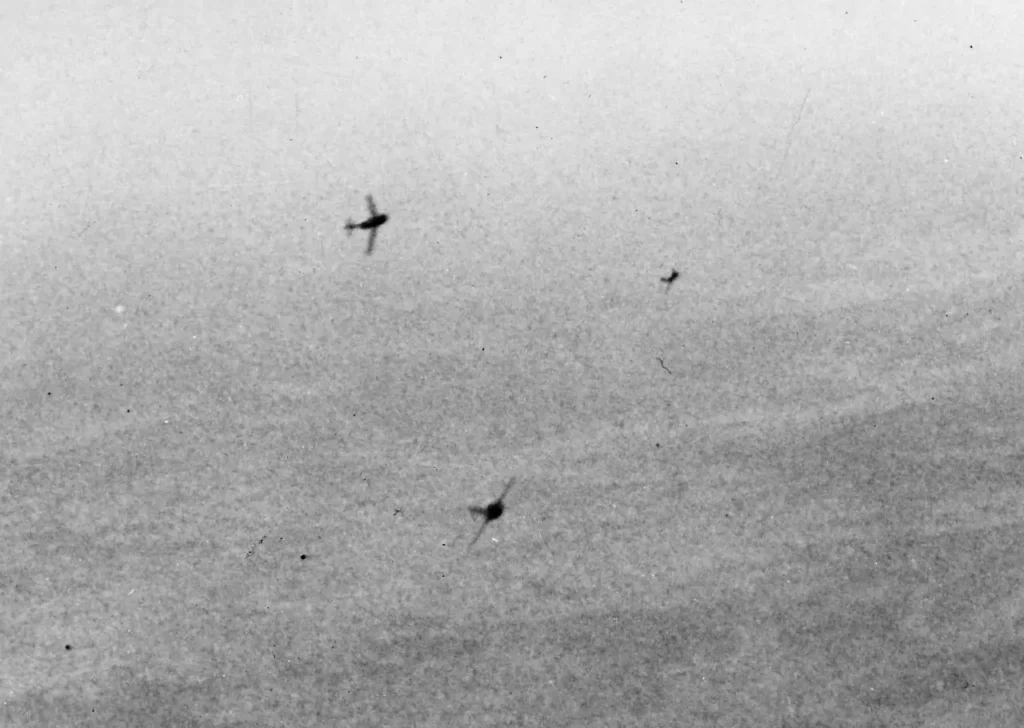
The army wanted to use the B-29s to bomb North Korean airfields, hard to spot at night. Launching daytime attacks became necessary, although it would prove poorly.
On Oct. 23, more than 50 MiG-15s faced the 307th bombardment group’s B-29s. Once again, the bombers’ 0.50-cal weapons did little against Soviet new-generation planes.
Of a total of eight B-29s, three were taken down; the rest barely made it out of the gunfire but not without suffering a great deal of damage. Most bombers were forced to do emergency landings, and just one returned to base successfully. At the end of the day, only three survived.
“Black Tuesday” was another hard lesson for the US Air Force. To avoid more of these defeats, the B-29 took advantage of the MiG-15’s lack of radar system and kept acting as a night bomber.
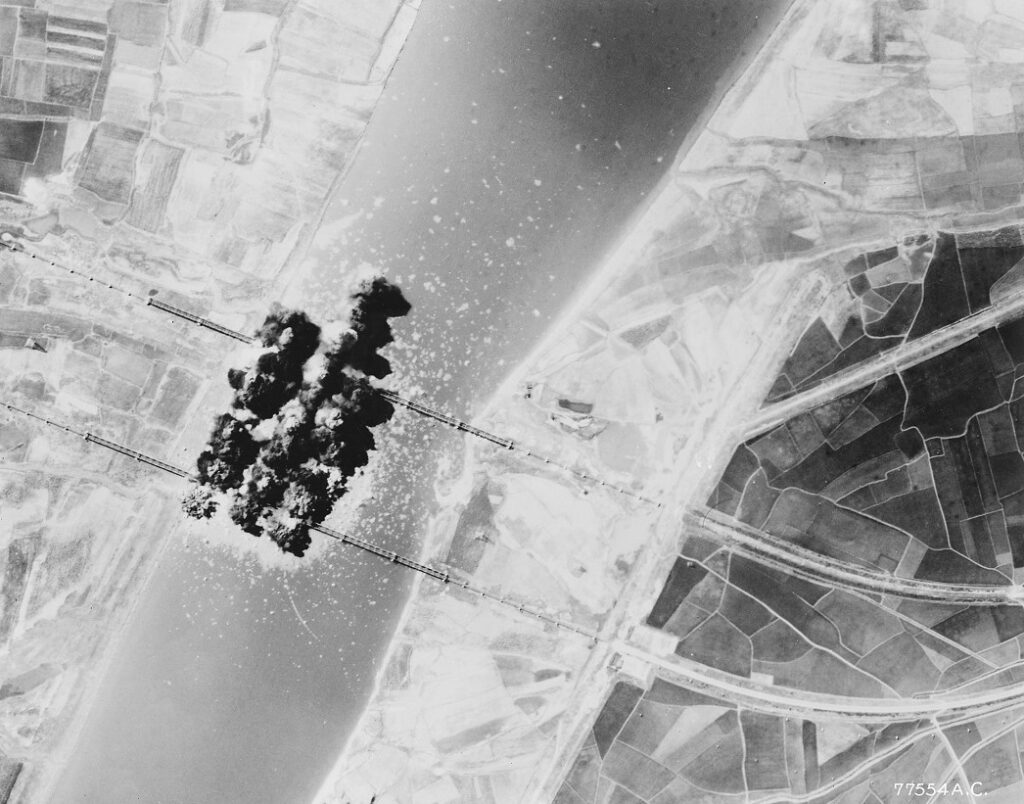
Aftermatch
Notwithstanding these defeats, the B-29 proved its worthiness in Korea. The aircraft continued serving in the war until its end in Jul. 1953. During that time, the bombers flew in 21,000 missions, dropped 167,000 tons of explosives, and merely spent 26 days away from the action.
A total of 34 B-29 were lost in the war: 16 to fighters, 14 to various causes, and four to anti-aircraft guns. In other words, less than one B-29 was lost for every 1,000 sorties.
On the other hand, B-29’s gunners brought down 27 enemy fighters—16 of which were MiG-15s—, plus probably shooting down another 17 and damaging 11 MiG-15s. Still, this number is likely to be an exaggeration: not a few B-29 gunners affirmed never even get a hit on a MiG-15.
One way or the other, the war exposed the weaknesses of an aging B-29 and overall piston-engine planes. Soon enough, the development of the B-36 and B-50 bombers stopped, while the B-52 and B-47, in turn, were set as a priority.
Further reading
- Boeing B-29 Superfortress Units of the Korean War (1950-1953)
- Known B-29 Superfortress Losses in Korea (1950-1953)
- The B-29’s Campaign in the Korean War: A Chronology
- B-29 Superfortress vs Mig-15: Air Battle results
Conclusion
A lot of characteristics that had never been seen or tested before were introduced by B-29. A wonder that cost the US almost $1 billion more than the top-secret atomic bomb project.
As such, it was superior to any bomber created before it in terms of capability.
And as for any technological marvel of its day, it had so many issues at first that General Curtis LeMay, who oversaw America’s bombing campaign against Japan, is rumored to have remarked that “it had more bugs than the Smithsonian“.
The geniuses who created the B-29 were able to gradually strengthen their soundness, and the aircraft eventually became more reliable and was able to fight several wars.
Selected Bibliography
- B-29 Hunters of the JAAF by Koji Takaki
- B-29 Superfortress in detail & scale, Part 2: Derivatives by Alwyn T. Lloyd
- B-29 Superfortress Units of the Korean War by Robert F Dorr
- B-29 Superfortress vs Ki-44 “Tojo”: Pacific Theater 1944–45 by Donald Nijboer
- Boeing B-29 Superfortress (Crowood Aviation Series) by Steve Pace
- Boeing B-29 Superfortress Manual 1942-60 (all marks) by Chris Howlett
- Boeing B-29 Superfortress: The Ultimate Look: From Drawing Board to VJ-Day by William Wolf
- Boeing B-50 (Air Force Legends) by Geoffrey Hays
- Inferno: The Fire Bombing of Japan, March 9 – August 15, 1945, by Edwin P. Hoyt
- Japan 1944–45: LeMay’s B-29 strategic bombing campaign by Mark Lardas
- The Enola Gay: The B-29 That Dropped the Atomic Bomb on Hiroshima by Norman Polmar
- Tupolev Tu-4 Superfortress (Red Star Volume) by Yefim Gordon
- Tupolev Tu-4: The First Soviet Strategic Bomber by Yefim Gordon
Now It’s Your Turn
I hope you found the B-29 data interesting and useful.
With that, it’s time to hear what you have to say.
Were any of these findings surprising? Or maybe you have a question.
Either way, let me know your thoughts in the comments section below
someone said the B-29s were used for commercial use, true or false